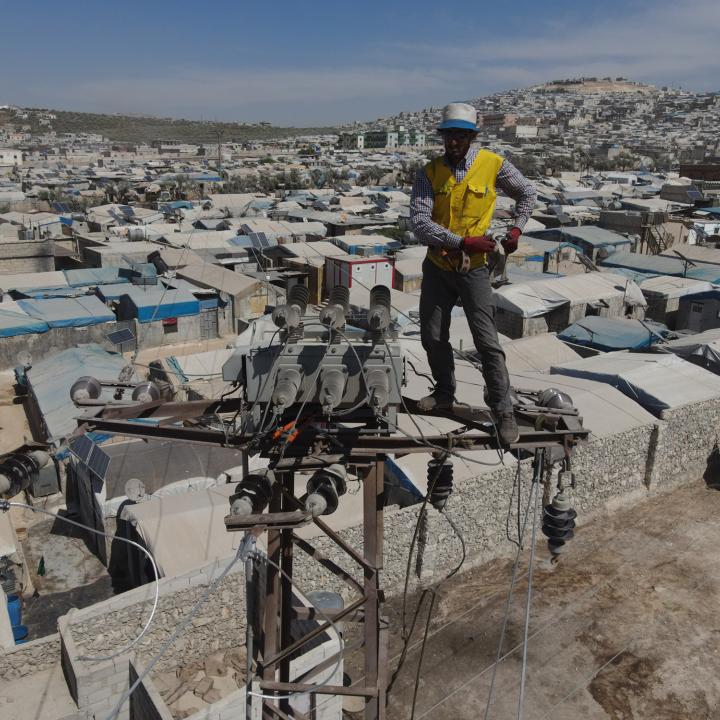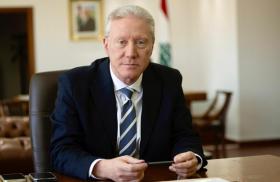
- Policy Analysis
- PolicyWatch 4093
Maintaining Momentum in Syria’s Energy Sector

New oil, gas, and infrastructure initiatives have continued rolling in since the Trump administration’s removal of sanctions, but they may amount to little in the long term unless more is done to build Syria’s own capacity, tamp down on political tensions, and address bureaucratic confusion.
On August 2, the Azerbaijani state energy company SOCAR announced that it will export 1.2 billion cubic meters of natural gas annually from offshore fields in the Caspian Sea through a recently repaired pipeline stretching between Kilis, Turkey, and Aleppo, Syria. The deal’s initial phase would supply 3.4 million cubic meters per day (mcm/d) to Aleppo’s Thermal Power Plant, generating around 900 megawatts of much-needed electricity. This supply could be increased to 6 mcm/d and sent further south now that a pipeline from Aleppo to Homs has reportedly been completed.
The announcement is the latest in a slew of energy deals intended to help Syria turn the lights back on post-Assad. Yet while gas imports can alleviate some short-term energy issues, bringing Syria’s own energy production back online will be crucial to the interim government’s reconstruction efforts after thirteen years of devastating civil war. Authorities in Damascus have claimed that U.S. sanctions are still impeding investment, but the Trump administration lifted all executive branch sanctions on June 30, and key congressional restrictions have been suspended as well. Today, the main barriers to redeveloping Syrian energy appear to be escalating internal political tensions and an unclear payment and contracting authority, both of which will only entrench the country’s chronic prewar corruption unless addressed promptly.
How the War Affected Energy Production and Reserves
At its 1996 peak, Syria produced a modest but significant 582,300 barrels per day of oil. Yet declining reservoir pressure and aging infrastructure soon reduced this amount, and the export blends Syrian Light and Syrian Heavy suffered accordingly. Output briefly improved before the civil war due to enhanced oil recovery efforts by firms like the British-based Gulfsands Petroleum, while natural gas production reached 9 mcm/d—a notable amount, but not sufficient for export.
The war devastated both sectors, however, causing an estimated total of $115.2 billion in damage. The Assad regime lost control of most energy-producing areas by 2012, forcing it to import oil and related products, including up to 100,000 barrels per day (bpd) from Iran. The collapse of gas output and the shuttering of power stations led to widespread outages, with some regions receiving just one hour of electricity per day.
Today, Syria produces around 90,000 bpd of oil from seventy-eight fields and an estimated (but unverified) 7.5 mcm/d of gas from twenty-eight fields (up from the last estimate—in 2012—of 5.6 mcm/d). The Kurdish-led Syrian Democratic Forces (SDF) control forty-one of these fields in Deir al-Zour province, including al-Omar (around 20,000 bpd), Jafrah (1,000 bpd), al-Tanak, and the nonoperational Conoco gas site. Despite the decline, Syria holds an estimated 2.5 billion barrels of recoverable oil reserves, most of which are heavy and sour grade (i.e., high sulfur content) and bound for Western European refineries.
Sanctions Relief Drives International Interest
The Assad regime’s collapse last December and President Trump’s May decision to lift U.S. sanctions spurred multiple foreign entities to express interest in not only exporting energy products to Syria, but also investing in the country’s upstream and downstream production. The prelude to the surprisingly rapid and haphazard cascade of sanctions relief came on March 11, when the United Kingdom lifted oil-related restrictions on Syria’s ten major energy production, transportation, refining, and marketing companies. This paved the way for other foreign players to take a look at Syria’s energy status and potential:
- A Saudi Aramco technical delegation reportedly assessed conditions and rehabilitation prospects at northeastern oil fields.
- Qatar offered to supply liquefied natural gas (LNG), generating it at a regasification platform at Jordan’s Aqaba port and transferring it to Syria through a moribund section of the Arab Gas pipeline.
- Gulfsands Petroleum CEO John Bell met with Syrian Energy Minister Muhammad al-Bashir—President Ahmed al-Sharaa’s brother-in-law and cousin—to discuss resuming operations in Block 26. (Like nearly all other international oil firms, Gulfsands declared force majeure and ceased production in 2011 following the outbreak of war.)
- The World Bank signaled support for the country’s energy revival after a Syrian delegation participated in its spring meetings with the IMF.
Yet the most headline-grabbing actions began in May, when President Trump announced that he would lift all sanctions and the Treasury Department issued General License 25 to execute this plan. Keen to get back into Syria—and into the good graces of Sharaa and Trump—many international firms did not wait for the full lifting of sanctions to make their move. For example:
- Turkey announced the repair of the aforementioned gas pipeline from Kilis to Aleppo.
- The Turkish companies Kalyon and Cengiz, alongside the Qatari firm UCC Holding and the U.S.-based firm Power International Holding, signed a whopping $7 billion strategic cooperation deal with Syria’s Energy Ministry. The agreement includes plans to generate 5,000 megawatts of electricity via four gas-fired power plants and a 1,000-megawatt solar plant—a significant step toward closing the 15,000-megawatt gap between current generational capacity and theoretical demand. Still, further investments in transmission and distribution infrastructure are essential.
- Damascus invited Tatneft and other firms from Russia—which is still Syria’s chief oil supplier—to resume local operations.
On June 30, the Trump administration issued Executive Order 14312, an omnibus decree lifting as many sanctions as possible apart from those requiring special congressional action. The rescinded measures include sanctions covering Syrian-origin oil, petroleum, and other energy products, spurring even greater foreign interest in direct involvement there. In addition to the August 2 Azerbaijani announcement:
- The U.S.-based firms Baker Hughes, Hunt Energy, and Argent LNG announced their intent to develop a master plan for Syria’s energy sector, starting west of the Euphrates River. Argent CEO Jonathan Bass, who was reportedly involved in lobbying efforts leading to Trump and Sharaa’s May meeting in Saudi Arabia, stated that “while U.S. companies would lead, funding would likely need to come from elsewhere.”
- In late July, Saudi Arabia sponsored an investment forum in Damascus, unveiled billions of dollars in deals that included $150 million for Syrian energy projects, and signed a bilateral memorandum of understanding covering petroleum supply, electricity, renewables, energy efficiency, and investment cooperation.
- Iraq and Syria reached an agreement on August 13 to study the repair and restarting of the Kirkuk-Baniyas pipeline, some of which is now part of the Syrian national grid.
Policy Recommendations
Although such announcements are a major shot in the arm for Sharaa’s interim government, the path to actually capitalizing on them remains rocky. For the first time in half a century, the biggest barriers to rebuilding Syrian energy have little to do with sanctions—rather, industry figures now say the main problems are local political tensions, violence, and confusion about bureaucratic responsibilities.
Recent government clashes with Druze militias in Suwayda province showed how difficult internal reconciliation will be, notwithstanding the regional ramifications signaled by Israel’s intervention. Although Suwayda has no fossil fuels, the episode was a harbinger of things to come in the energy-rich northeast, where government negotiations with the SDF have stumbled. Further gridlock, unresolved tensions, and the possibility of military intervention by Turkey or other players could make the northeast too unstable to restart energy production, let alone expand the sector. Washington should therefore do everything it can to bridge the gap between Damascus and the Kurds—whose forces clashed last week—over military and political integration, balancing the government’s desire for greater centralized control with the SDF’s military capacities and aspirations for some degree of autonomy.
Concerning bureaucratic barriers, one analyst has noted that “investors still face difficulties in communication” stemming from the lack of clear “boundaries of authority between ministries, the Syrian Investment Authority, and other bodies and councils appointed in recent decrees.” Syrian and Saudi officials are seemingly attempting to address this problem via discussions about “knowledge exchange” on energy projects, policies, and regulations, but much more needs to be done. In particular, Washington should work closely with Syrian authorities on the legal basis for new energy investments ahead of and after the country’s reunification, pointing out that Syrian American business ventures in the United States and elsewhere thrive in part because these jurisdictions have instituted the necessary rule of law and regulatory practices. Cutting through the confusion and red tape will help the new Syria clamp down on the rampant corruption that bedeviled the Assad regime—and, sadly, continues in its wake.
Audrey Kost is a former research assistant with The Washington Institute’s Rubin Program on Arab Politics. Andrew Tabler, the Institute’s Martin J. Gross Senior Fellow, formerly served as senior advisor to the U.S. special envoy for Syria and director for Syria at the National Security Council.



